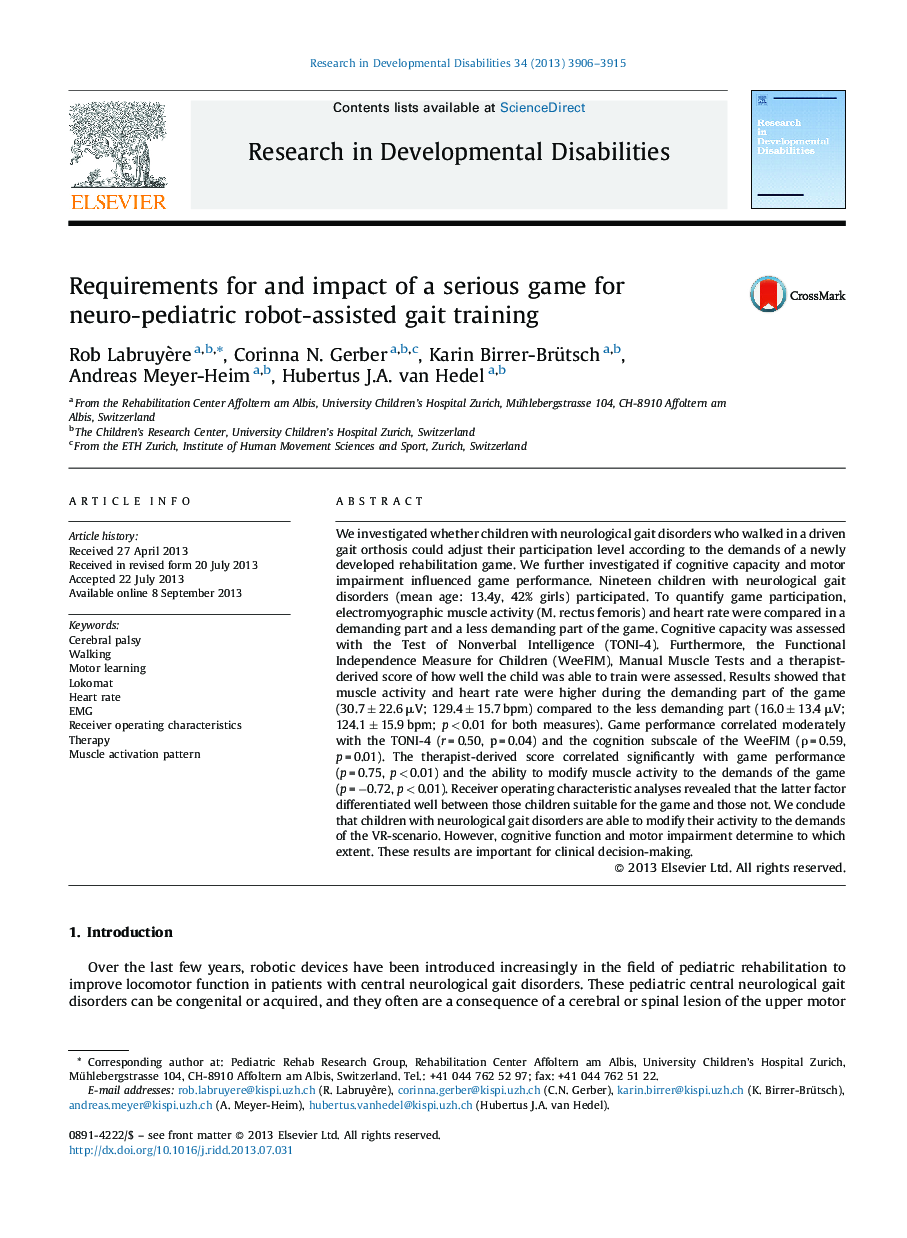| کد مقاله | کد نشریه | سال انتشار | مقاله انگلیسی | نسخه تمام متن |
|---|---|---|---|---|
| 10317650 | 621922 | 2013 | 10 صفحه PDF | دانلود رایگان |
عنوان انگلیسی مقاله ISI
Requirements for and impact of a serious game for neuro-pediatric robot-assisted gait training
ترجمه فارسی عنوان
الزامات و تأثیر یک بازی جدی برای آموزش راه رفتن با ربات های کودکان و نوجوانان
دانلود مقاله + سفارش ترجمه
دانلود مقاله ISI انگلیسی
رایگان برای ایرانیان
کلمات کلیدی
موضوعات مرتبط
علوم زیستی و بیوفناوری
علم عصب شناسی
علوم اعصاب رفتاری
چکیده انگلیسی
We investigated whether children with neurological gait disorders who walked in a driven gait orthosis could adjust their participation level according to the demands of a newly developed rehabilitation game. We further investigated if cognitive capacity and motor impairment influenced game performance. Nineteen children with neurological gait disorders (mean age: 13.4y, 42% girls) participated. To quantify game participation, electromyographic muscle activity (M. rectus femoris) and heart rate were compared in a demanding part and a less demanding part of the game. Cognitive capacity was assessed with the Test of Nonverbal Intelligence (TONI-4). Furthermore, the Functional Independence Measure for Children (WeeFIM), Manual Muscle Tests and a therapist-derived score of how well the child was able to train were assessed. Results showed that muscle activity and heart rate were higher during the demanding part of the game (30.7 ± 22.6 μV; 129.4 ± 15.7 bpm) compared to the less demanding part (16.0 ± 13.4 μV; 124.1 ± 15.9 bpm; p < 0.01 for both measures). Game performance correlated moderately with the TONI-4 (r = 0.50, p = 0.04) and the cognition subscale of the WeeFIM (Ï = 0.59, p = 0.01). The therapist-derived score correlated significantly with game performance (p = 0.75, p < 0.01) and the ability to modify muscle activity to the demands of the game (p = â0.72, p < 0.01). Receiver operating characteristic analyses revealed that the latter factor differentiated well between those children suitable for the game and those not. We conclude that children with neurological gait disorders are able to modify their activity to the demands of the VR-scenario. However, cognitive function and motor impairment determine to which extent. These results are important for clinical decision-making.
ناشر
Database: Elsevier - ScienceDirect (ساینس دایرکت)
Journal: Research in Developmental Disabilities - Volume 34, Issue 11, November 2013, Pages 3906-3915
Journal: Research in Developmental Disabilities - Volume 34, Issue 11, November 2013, Pages 3906-3915
نویسندگان
Rob Labruyère, Corinna N. Gerber, Karin Birrer-Brütsch, Andreas Meyer-Heim, Hubertus J.A. van Hedel,
